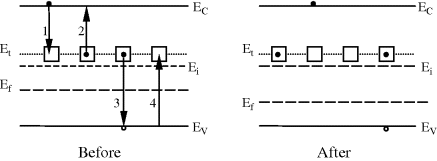4.11 Nonradiative Recombination
The radiative recombination in indirect-gap semiconductors, in particular in Si, is very inefficient. The excess carriers in silicon decay mostly by nonradiative processes involving trap levels or by the Auger recombination process. In the following, these two processes are discussed.
4.11.1 Recombination via Traps
The dominant recombination mechanism in silicon is via traps. The theory of this process was developed by Shockley and Read 19 and modified by Hall 20. The model is thus referred to as the SRH model. The mechanism involves four electron and hole transitions as shown in Figure 4.9. A trap level Et first captures an electron (process 1), and then a hole is captured by the trap filled by the electron (process 3): the direction of the arrow indicates the transition of an electron, and the hole moves oppositely. The combined result of electron and hole capture is a recombination of the pair. As shown in the right part of the diagram, the trap is free to capture another EHP after this. The inverse processes are the emission of an electron from the filled trap into the conduction band (process 2) and the emission of a hole from an empty trap into the valence band (process 4).
Figure 4.9 Four basic steps in trap-assisted recombination: (1) electron capture, (2) electron emission, (3) hole capture, and (4) hole emission.

The rate of electron capture ...
Get Silicon Photonics: Fundamentals and Devices now with the O’Reilly learning platform.
O’Reilly members experience books, live events, courses curated by job role, and more from O’Reilly and nearly 200 top publishers.

